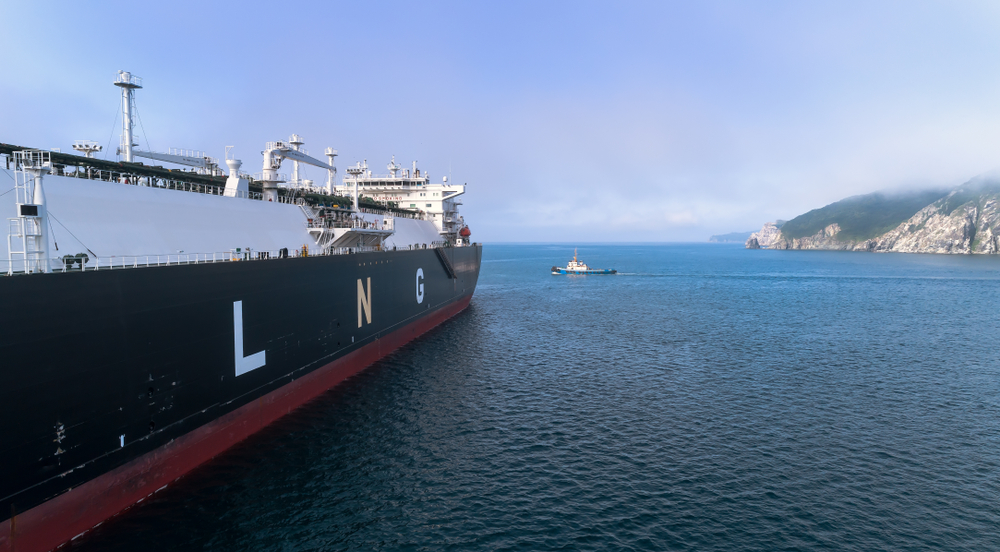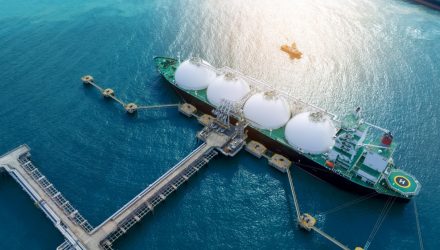VettaFi recently sat down with Ben Nolan, managing director at Stifel, to discuss the outlook for the global LNG market, third-quarter earnings, and overlooked investment opportunities in the space.

VettaFi: What’s your long-term outlook for the global LNG market? What are some of the factors driving global demand growth?
Nolan: I’m constructive on long-term demand. My midrange case, at least through 2030, I’m expecting 5%-6% demand growth annually. Ultimately, I expect demand to continue to grow well beyond 2030, probably 2035 or 2040 at least, before we see a peak.
To put numbers on that: In 2022, a little over 400 million tonnes of LNG was produced annually. I think we ultimately probably double that. It’s going to take a while to get there, but I think that’s the direction that we’re headed. There are a number of drivers.
LNG Demand Growth Drivers
One is growth of the economy. That’s the most impactful and is going to be driving at least half, probably more than half, of all incremental demand. Also, in certain situations, and maybe it’s a combination of these things, you have a decline of domestic natural gas. And so LNG is needed to offset that. You have places in Asia like Pakistan and Bangladesh where they’re both a growing economy and they’re seeing less domestic production of natural gas that needs to be replaced.
Then you have the energy security side of it, which is what we’ve seen in Europe. They went from about 40 million tonnes of imports pre-Russia to now about 80 million tonnes; so, a doubling of their LNG demand. To some extent, it’s replacing Russian gas that isn’t available or even North Sea gas. But a lot of it is simply not wanting to be reliant on a single source. LNG offers diversification of your natural gas supply.
The last dynamic is fuel switching. That’s typically driven by the desire to reduce emissions, so coal is the primary candidate. But there’s also economic fuel switching that happens as well and in certain regions where they use diesel or fuel oil for power generation. Depending on what the relative price of LNG and oil is, you can save a whole lot of money by shifting from oil to gas.
VettaFi: How could near-term natural gas supply interruptions (Tamar field, Balticconnector pipeline, Australian strikes) impact the LNG market?
Well, I think we see that in Europe, right? You have the Nord Stream 2 or other potential issues. You have developed economies that have a very strong natural gas appetite and healthy consumption and capital to pay for it. They’re willing to pay a premium for that natural gas. I would say it’s probably not the main driver for demand growth; it’s just more places growing and needing more fuel.
But certainly, I think what we have seen is LNG and LNG infrastructure adds flexibility to energy supply chains. Even if you’re not always going to need it, there are a whole lot of people that want to have the option so that they’re not tethered to a single source of energy where something could happen and then all of a sudden you’re out of options and you have intermittent power.
VettaFi: What is your view on LNG prices this winter and into 2024?
I think it’s tricky. At the moment, there are sufficient level of supply or inventory in Europe. European gas inventory is pretty full. But as we’ve seen in the past few weeks, it doesn’t take very much to upset the applecart here. That is the case because you don’t have a toggle in Russia that can increase supply if demand is higher.
So, the balancing agent is LNG. I’m talking mostly about Europe because they’re kind of the swing buyer in this market. Historically, it had been Asia but right now it’s Europe. And so, to the extent that it gets really cold, for instance, Europe could deplete their inventories really, really quickly, or if there is a disruption like what we are seeing now in Israel. That natural gas being produced in offshore Mediterranean, most of it doesn’t actually flow into Europe. But it does go into Egypt, where there are two LNG facilities. Then the vast majority of that LNG goes north to Europe. It’s not even a lot, but it doesn’t take a lot — and that’s sort of the point. Europe is living on a knife’s edge. They were last year too and lucked out by the fact that it was a warm winter.
Now, they have a whole lot more LNG import infrastructure. When it does get cold, or if there is a disruption, they can buy a lot and that would cause the price to go up significantly because supply is effectively at full utilization.
Price Influences
If you can produce it without there being some sort of operational difficulty, then you are producing LNG at the moment; you’re making whatever you can get for it. If demand goes up, the only toggle is price. So, if it gets cold in Europe, demand will go up and that price toggle will tighten.
Right now, LNG prices in Europe are $15-$16. They obviously went north of $60 a year ago and that ended up proving to be too high because the winter wasn’t too bad, but I don’t think we’ll get back to that same level. People are a little bit more prepared for it. But it could certainly tighten further. The flip side of that is because Europe is in a relatively good position today. If it’s a warm winter, then the price could actually go down. I think we’re very, very weather dependent at the moment. Aside from black swan events and geopolitical things, we’re watching the forecast from the natural gas perspective.
VettaFi: What topics or company updates are you focusing on during third-quarter earnings reports?
Nolan: It depends on the company. For U.S. LNG producers, we’re in an interesting place where there’s been a lot of incremental development this year. There’s been a number of projects that have moved forward and there are a number that are very close to moving forward. But there’s neither infinite supply of natural gas in the United States – there’s a lot but it’s not infinite – and nor is there infinite demand. What it potentially could lead to, and I think what people are thinking about, is timing mismatches. We probably won’t see those materialize for a few years, but given all the new supply that’s going to be coming out of the U.S., does that push up the domestic price of natural gas? And if it all comes to the market in a relatively short period of time, does it push down the price of international LNG?
We could be in this for probably a short period of time because demand is continuing to grow. But where you see a conversion of the U.S. natural gas price and the international LNG price, that doesn’t leave a whole lot of margin for the LNG producers.
Now, most of the LNG producers sell on long-term contracts, and so it’s the customers who are taking a price risk. Nonetheless, it is sort of an interesting time where, at the moment, everything is good. As we look out a few years into the future, the question is, all right, is there going to be a price disruption? How much more can be built? How much more will be built?
International LNG Producers
From an international perspective, while the U.S. is by far the biggest producer of LNG, we’re not in a bubble. The Qataris are increasing their production. There are a lot of places in Africa that could increase production, like Mozambique, or Tanzania, or Mauritania and Senegal, or Congo, you name it. Basically, if it has a coastline and it’s in Africa, they probably have natural gas that they could export and probably don’t have a strong domestic market for it. Typically, it’s the oil majors that are developing those projects.
I think around the quarter here, I think a lot of the commentary is going to be longer-term focused. None of us can predict the weather very well, right? So it’s going to be, how are you thinking through the end of the decade?
VettaFi: What are some investment opportunities or areas you think are currently being overlooked or misunderstood?
I think you have two different dynamics. From a short-term perspective, I think some of the LNG names are likely to trade with LNG prices. So you can look at over the last several years what names have been most closely correlated to LNG prices. The way I think about it is that you probably have asymmetric upside. Prices could go down, but at the moment, I don’t know that would have a dramatic impact on the share prices because they already have come down some. Or they could go up a lot and then the I think the equities could come up. In that respect, from a short-term trading perspective, the name that jumps out at me is New Fortress Energy (NFE). They have had the closest correlation to LNG prices.
Longer-Term Opportunities
From a longer-term perspective, what is a little bit interesting to me are some of the developments outside the U.S. In the U.S., you’re going to have a lot more volume and cash flow and everything else. However, it’s a highly competitive market and it’s hard to really earn outsized returns.
There is potential to earn outsized returns in some of these places where the gas is stranded, like Africa. Where we know that the gas is there, and it’s basically worthless in the ground. Or, it might even be flared right now so it’s physically being wasted and causing emissions. If you could take that sort of free gas and monetize it and bring it to another part of the world, that has potential for outsized return. The problem is these are hard places to do business.
For that, the name I like is Golar LNG (GLNG). They have these floating LNG facilities, they’re focused on Africa, so I think there could be some good opportunities there that they’re pretty close to. Then longer term, the other one that I would mention is the 800-pound gorilla Cheniere (LNG). They have a lower cost of capital than anyone — the cheapest incremental development in the U.S. because it’s all expansion, so they’re not building anything from the ground up. They have the best track record, the most money, and all of these kinds of things. The big get bigger, and to some extent that’s priced into the stock, but in time, it’s just going to continue to inflate, I think.
VettaFi: Which companies are your top picks right now?
I would say rank order of the LNG names are probably Golar LNG (GLNG), New Fortress Energy (NFE), and another one that is pretty undervalued and is going to take some time to develop is NextDecade (NEXT), and then Cheniere (LNG)
They’re not on the list because they’re not really an LNG producer. But I do think it’s worth mentioning that, as you continue to grow the industry, the people that provide the nuts and bolts of that growth are going to benefit as well, so someone like a Chart Industries (GTLS) or Baker Hughes (BKR). But they’re going to benefit as well from providing the kit that enabled all of this.
For more news, information, and analysis, visit the Energy Infrastructure Channel.

